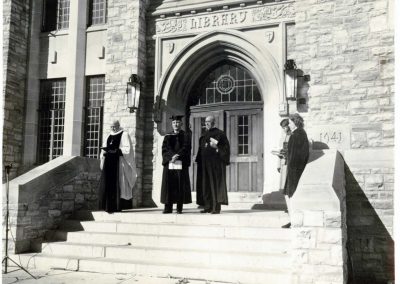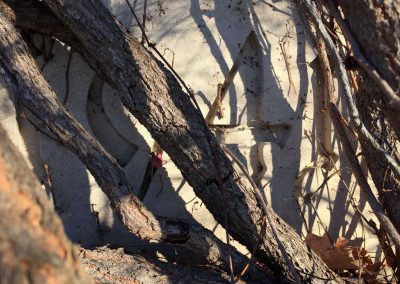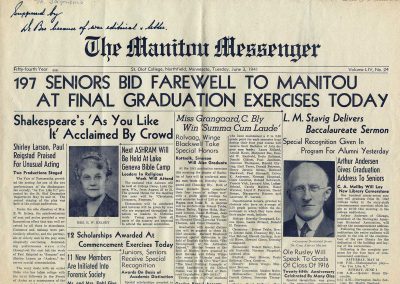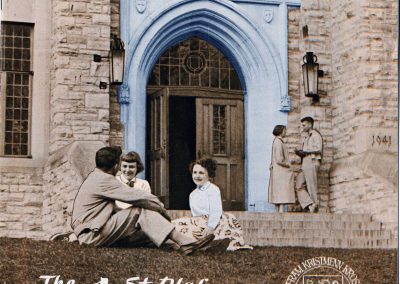Rolvaag Memorial Library Cornerstone
Emily Hoar
The cornerstone of Rolvaag Memorial Library, now shrouded in a curtain of ivy, conceals an interesting past. Built entirely through the efforts of alumni and friends of St. Olaf College, the library held its cornerstone dedication ceremony June 3, 1941. Earlier that morning, a freshly printed edition of the Manitou Messenger announced the cornerstone ceremonies beside an article on the class of 1941. Within its pages were published two anti-war opinion pieces on the current war raging in Europe and the strong possibility of the United States entering it: “A Fairy Story—For Our Children” and “Our Children Will Not Fight.”
The first was an allegory on childish pettiness between two pseudonym characters: “Chitler” (Germany’s Nazi leader, Adolph Hitler) and “Hamberlain” (Great Britain’s former Prime Minster, Neville Chamberlain).
The second expressed that St. Olaf students, or “our children” of the Depression and the first World War, had grown up in hardship and had been promised peace: “And when [World War II] is all over—those of us who come back—those of us who have sliced out the best years of our life with a bayonet—those of us—and there won’t be many left—will swear to God—our children will never have to fight a war for us.”
Jane Nelson Rossing ’42, then editor of the Manitou Messenger, recalled in an oral interview (May 10, 2002) that the newspaper had been printed and placed in faculty and student mailboxes. When President Lars W. Boe read the issue, he became incensed and immediately ordered all the newspapers withdrawn from the mailboxes and destroyed.
In the spring of 1942, President Boe wrote in a letter to Rossing: “I am frank in saying that I have not agreed with the attitude of the Messenger ever since last year when I found it necessary to take rather arbitrary action. I am not in position where I can back away from responsibility when mistakes are made and pass it on to others.”
Rossing was soon summoned to the president’s office and as she recalled, he did the talking, and she did the listening. Rossing stood by her convictions of printing the editorial, stating, “… the paper was run by students. This is how I felt and how other students felt, so we were going to print it.”
Today three banned copies of the Manitou Messenger are known to have survived, including President Boe’s. Apparently one copy was slipped into the cornerstone by Arthur C. Paulson (English faculty advisor to the Manitou Messenger).
Rieber Paulson, son of Professor Paulson, said his father did not agree with the president’s assessment of the newspaper and placed his copy into the cornerstone’s time capsule during the dedication ceremony while President Boe attended to other matters.
A Year That Will Live in Infamy!
The St. Olaf College library held its cornerstone dedication ceremony June 3, 1941. Source St. Olaf College Archives
On the Threshold of History
Library Dedication, October 14, 1944. From left: Johan A. Aasgaard and President Clemens M. Granskou. Source St. Olaf College Archives
Rolvaag Cornerstone
The cornerstone was placed to the right of the door and is now covered in ivy. Creator Emily Hoar
Rolvaag Cornerstone (Close-Up)
The cornerstone was placed to the right of the door and is now covered in ivy. Creator Emily Hoar
Our Children Will Not Fight!
Editor’s sentiments: “Our children” of the Depression and the first World War have grown up in hardship and had been promised peace: “… And when [World War II] is all over—those of us who come back—those of us who have sliced out the best years of our life with a bayonet—those of us—and there won’t be many left—will swear to God—our children will never have to fight a war for us.” Creator Jane Nelson Rossing ’42, editor of the Manitou Messenger, June 3, 1941 Source St. Olaf College Archives
Freedom of the Press
Suppressed issue of the Manitou Messenger, June 3, 1941. Source St. Olaf College Archives







Recent Comments